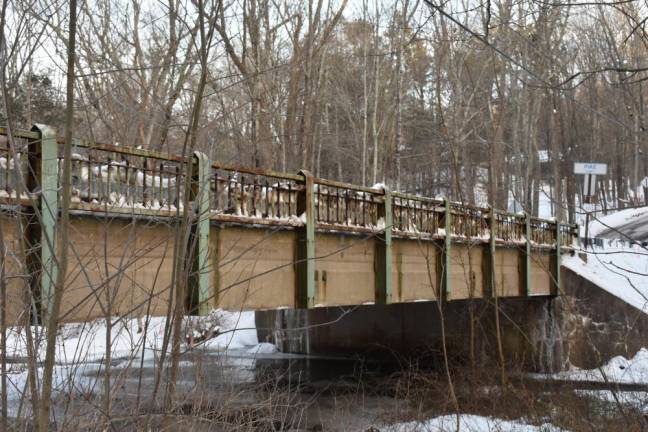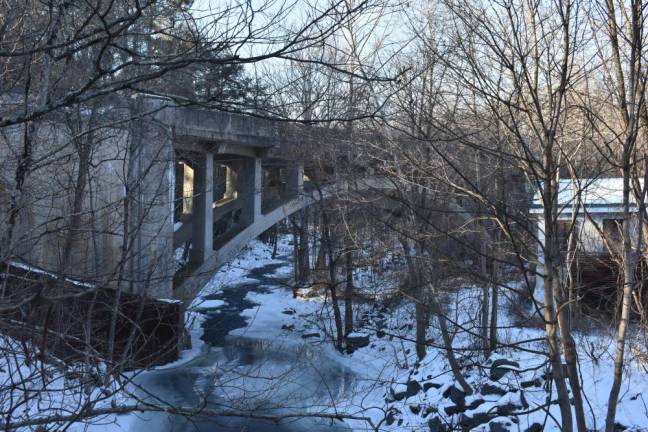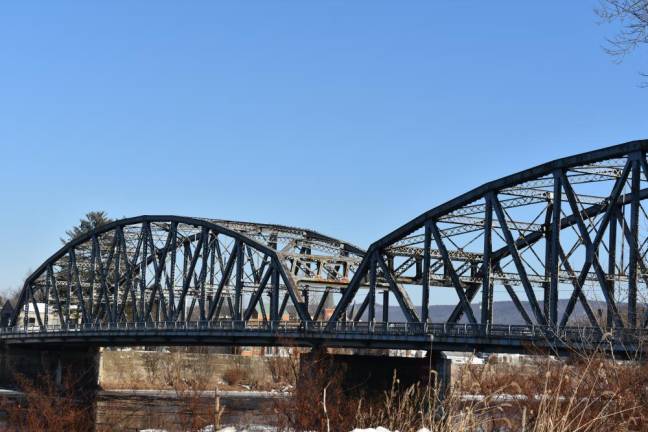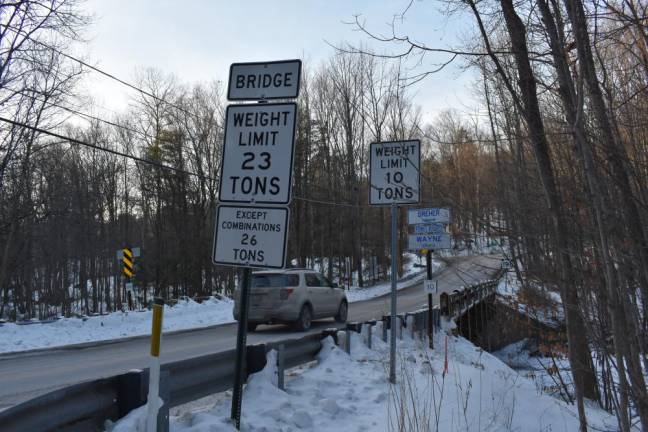Even in a state filled with aging bridges, Pike County’s stand out
Infrastructure. The two main bridges in Milford Borough, over the Sawkill and Vandermark creeks, are firmly in the “poor” bucket; one has a worse rating than the bridge that collapsed in Pittsburgh last month. A bridge over the Wallenpaupack has been downgraded to “critical.” More than a quarter of the 218 bridges in Pike County are currently in poor condition, double the statewide rate.




Go for a drive in the Delaware River Valley, and soon enough you’ll cross a bridge. Ideally, you’ll hardly notice, except perhaps to look down at the river or appreciate a bit of elegant engineering.
Increasingly, however, you may find it hard to ignore you’re on a bridge, and for reasons besides the view. Rough road conditions, weight limit signs, congestion, and detours have become ever more common as more of Pennsylvania’s sprawling network of aging bridges falls into disrepair each year.
Pike County is particularly hard-hit: more than a quarter of its 218 bridges are in poor condition, according to the Pennsylvania Department of Transportation’s bridge conditions report. That’s double the rate of poor bridges to be found statewide.
Then there’s the nightmare scenario, which unfolded in Pittsburgh early last Friday morning, when a 1970 steel bridge that had been rated poor for years collapsed and fell 60 feet with a city bus on it. Ten people were injured, and four were sent to the hospital. A gas line running beneath it ruptured.
This all happened on the same day President Joe Biden was scheduled to come to Pittsburgh to tout the passage of his $1 trillion infrastructure package, signed into law in November. Pennsylvania is set to receive $1.6 billion in federal funds over five years to repair and replace its bridges — the third-most bridge money of any state, including more-populous Texas and Florida.
“There are another 3,300 bridges here in Pennsylvania, some of which are just as old and in just as decrepit condition as that bridge was,” said Biden. “We’re going to rebuild that bridge, along with thousands of other bridges in Pennsylvania and across the country.”
“It was truly surreal to see a bridge I’ve driven across thousands of times — including the very day before the collapse — crumbled and detached on both ends,” said Pennsylvania Lieutenant Governor John Fetterman, who along with Governor Tom Wolf met the President at the collapse site. “Our infrastructure is failing us. Look, I don’t want these bridges fixed as a Democrat, independent, or Republican. I just want these bridges fixed as a dude who drives his kids over them almost every day.”
From bad to worse
The two main bridges in Milford Borough – the Route 209 bridge over the Sawkill Creek, built in 1942; and the Route 6 bridge over the Vandermark Creek, built in 1935 – are firmly in the “poor” bucket. The concrete Route 209 bridge has fallen a step lower into “serious” shape, which means the deterioration has “seriously affected the primary structural components.” That’s a worse rating than the bridge that collapsed in Pittsburgh, which is under investigation.
Both the Milford bridges are on PennDOT’s schedule to be rehabilitated starting in the next year or two, said Milford Mayor Sean Strub. “There’s a tremendous backlog of deferred maintenance on bridges all over the country and Pennsylvania is no exception,” said Strub. “I’m glad there is finally some federal funding to address the problem.”
The iconic Mid-Delaware Bridge, rated poor for its deck condition, is likewise on the state’s docket of near-term projects. The 1939 streel truss bridge connects Matamoras, Pa., and Port Jervis, N.Y., over the Delaware River, carrying about 15,440 cars a day.
But the most run-down bridge in the county is an unremarkable, 67-foot stretch of concrete articulated by rusted, green-painted railings that straddles Pike and Wayne counties over the Wallenpaupack Creek. Built in 1955, its rating fell to poor in 2017 and is now “critical,” which means deterioration has advanced and the bridge will be closely monitored, or closed, until corrective action can be taken. A 2017 inspection found that “bank and embankment protection is severely undermined,” according to bridgereports.com, an unofficial site that compiles national bridge inventory data.
Other than a weight limit sign of 23 tons – a dime-a-dozen sight in this rustic township – there is no hint to the sporadic cars passing over that anything is amiss. Not until you get out of the car and pick your way down toward the streambank can you see the badly rusted metal railings, and the network of cracks in the cement foundation. This beleaguered bridge has not been forgotten, just deferred. It too is on PennDOT’s schedule of near-term projects.
Weight limits are not a good sign. They’re a last-ditch effort to slow the deterioration and extend the service-life of structurally deficient bridges. Though most drivers don’t have to think about weight limit signs, they do affect the general public – and not just because of their ominous undertones. By forcing truck detours, weight limits end up raising the cost of goods and services, according to PennDOT. They’re also a harbinger of hard times to come, as a literal indicator of delayed maintenance that leads to expensive fixes later on, along with a risk of eventual closures and detours. One bridge closure can cost Pennsylvania drivers approximately $70,000 per day in lost time, fuel and car maintenance costs, according to PennDOT.
Since 2011, commute times have increased by 7.6% in Pennsylvania, according to Infrastructure Investment and Jobs Act literature from Biden’s office. On average, each driver pays $620 per year in costs due to driving on roads in need of repair.
Million-plus-dollar jobs
Bridge rehabilitations can be million-plus-dollar projects, and can run to $100 million for interstate bridges. Thirty one Pike County bridges are currently on PennDOT’s four-year schedule of transportation improvement projects, which will cost the state nearly $277 million. These are monster endeavors, which is why they so often get kicked down the road.
The Mid-Delaware Bridge – which underwent $2.6 million in structural repairs in 2010 – requires a $14,900,000 rehabilitation this time around. The rehab of the Route 209 bridge in Milford, projected to occur in 2023, is a $3,697,750 job that includes a bevy of side projects like the construction of a temporary 200-foot bridge across the Sawkill Creek to accommodate traffic while the main bridge is under construction, and a new drainage pipe and outfall to improve drainage around the historic Callahan House that abuts the bridge. Even the nondescript “worst bridge in the county,” which sees just 246 cars a day, will cost upwards of $3 million to restore.
Things get even trickier when a bridge is owned by a township or a county with their more modest coffers. Pike County’s 182 state-owned bridges are in relatively decent shape, with 19 percent in poor condition and the majority “fair.” But its 36 locally owned bridges are overwhelmingly neglected, with just two in good shape and 24 in poor condition. In a creative wrinkle, the federal bridge program requires states to use at least 15% of the new money to rehabilitate or build smaller bridges, not only the major arteries and interstates that make up the National Highway System.
But how far the federal funding will trickle down remains a big question mark. “The distribution of the federal funding is likely to be very complex and may not involve county owned bridges,” said Michael Lamoreaux, engineer for Pike County and principal at McGoey Hauser & Edsall Engineering, whose bridge projects include the recent rehabilitation of the historic Mott Street Bridge connecting Milford Borough to Dingman Township for pedestrian use. “We do have numerous bridge projects ongoing, but they are not utilizing the funding you are speaking of.”
Exactly which bridges will get federal funding will be announced in the upcoming months, said Susan Hazelton, assistant district engineer for PennDOT’s District 4. The new funds will get folded into the department’s 2023 Transportation Improvement Plan, which is being updated now, she said.
The only major transportation project that’s been announced for Pike County so far is $2.4 million of federal infrastructure dollars to be spent on resurfacing part of Pennsylvania Route 590 in Lackawaxen Township.
Getting creative
In the meantime, Pike County has had to get creative to keep its bridges operable. The Pike County Commissioners established a $5 registration fee in 2018 to maintain county-owned infrastructure, namely its 17 bridges, which were declining without a sustainable way to pay for their maintenance.
The Fee for Local Use has generated $350,000 a year, which was matched by a $2 million state grant. The county parlayed that money to fund a $5 million bond – enough to fund five bridge repairs. The first of those was the $537,350 rehabilitation of Kimbles Bridge in Hawley Township, which reopened in December.
In the past, they county only had the resources to do “band-aid repairs,” Pike County Commissioners Chair Matthew Osterberg told the Pike County Courier in December. “It wasn’t anybody’s fault,” Osterberg said. “There just wasn’t any money.”
“The distribution of the federal funding is likely to be very complex and may not involve county owned bridges. We do have numerous bridge projects ongoing, but they are not utilizing the funding you are speaking of.” Michael Lamoreaux, engineer for Pike County



